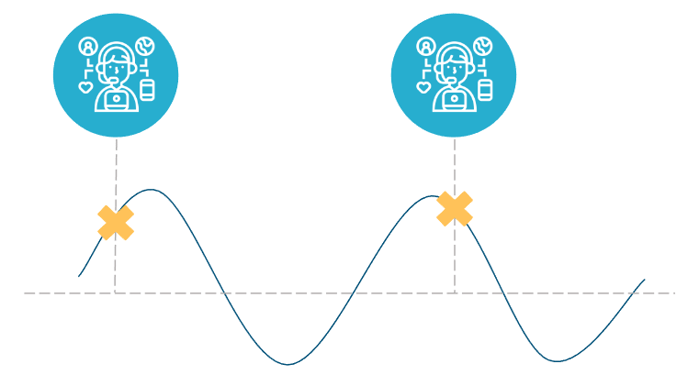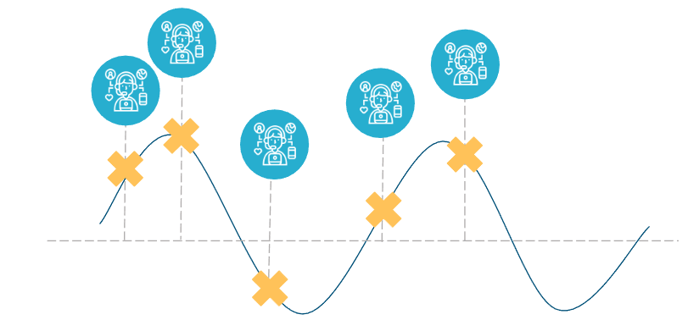Why are regular, short intervals important in surveys?
Insights into employee satisfaction are only valuable if these insights also reflect the current situation - in all its colorful facets. At TeamEcho, we therefore trust science and rely on short intervals.
To start with: which interval best suits your company and your teams depends above all on your communication culture and speed. Therefore, there is no "one right interval" - sometimes it even makes sense to use different intervals in different teams.
The answer to the perfect interval is therefore very individual - but one thing is true for all companies: Scientific findings show that survey intervals of more than four weeks are no longer suitable for reflecting the current mood.

Take volatility into account
If there are longer breaks between the individual surveys, you run the risk of just chasing the trends instead of recognizing them at an early stage. This is because the results are largely out of date as soon as you analyze them. The reason for this is the high volatility of many employee satisfaction factors.

If you choose too long intervals between surveys, you'll never see the complete picture and miss any fluctuations. Employee satisfaction and engagement consists of a mix of very different factors, some of which are very stable, but many of which are also very susceptible to fluctuation.

The intelligent TeamEcho algorithm therefore takes into account the varying volatility of the individual components and, for all TeamEcho question sets, ensures both that
- factors are queried as often as necessary (to always enable an up-to-date picture) and
- individual questionnaires are as short as possible (in order to allow for short and unintrusive application).
In order to maintain the perfect balance, we offer our TeamEcho question sets at the following intervals:
- weekly,
- bi-weekly and
- four-weekly.
Bite-sized results
Another advantage of short intervals: The individual surveys divide your results into bite-sized morsels.
This makes your analysis much easier, because as a team leader you don't have to sift through a mountain of confusing results, but can process the results of the individual surveys quickly and in a targeted manner.
Example:
In TeamEcho Insights, our algorithm asks question set per short survey:
- in weekly interval: 2-3 questions,
- in the bi-weekly interval: 4-5 questions,
- in the four-week interval: 9-10 questions.
Regularity builds trust and promotes motivation
If you regularly ask your team members how they are doing, you also have regular opportunities to give feedback and discuss measures at short intervals. This gives your employees the feeling that "something is really happening.
They feel taken seriously and valued - which in turn strengthens motivation, commitment and loyalty to your company in the long term.
Short surveys increase response rate and quality
Short survey intervals make it possible to ask as few questions as possible per survey. This allows you to counteract the fatigue effect of surveys. The quality of responses is significantly higher with short surveys, because your team members need very little time and can still concentrate sufficiently on each individual question.
The response rate is also significantly higher with short surveys than with lengthy, traditional surveys.
Read on for helpful tips on how to analyze TeamEcho Lights.
Learn more about how to derive action from your results here.
For a brief introduction to our scheduler, check out this article.
In this article we show you how to choose the right TeamEcho question set.